#pmmm discussion
Text
While we all are pretty much aware that this is Madoka's concept art outfit finally being used for her new Magical Girl design, there seems to be a lock and some chains around her ribcage. The first thing I thought about was the metaphor “hearts are wild creatures, that's why our ribs are cages” which is meant to illustrate that the heart cannot be governed, that it will go anyway it wants, that it is uncontainable, hence the “wild creature” title, and the heart being a “wild creature”, needs to be encased, limited, caged, hence the “rib cage”. This could symbolize a lot in terms of Madoka's character, but one of my theories is that Madoka's memories of every loop where Homura fought for her and never gave up, the realization that someone like Madoka, whom has never seen herself as worthy of anything, let alone love, unless she was helping or being of use to someome else, actually had someone all this time who's loved her for who she is, not what she can do for others, the clarity of “oh. this is the love letter I've always wanted,” the reciprocation of Homura's love that transcends time and space, all of that is locked away with the final memory wipe at the end of Rebellion. Maybe the metaphorical key to unlocking it is her finally regaining all of those memories, all of that love. Of course, she'd have to regain her godhood to do so. My second theory is that maybe this is meant to symbolize Madoka's ultimate sacrifice being locked away both as a means to keep her alive as a human and as a means to spare Homura anymore grief; maybe eventually Homura's acceptance of her death and acknowledgement of her grief will be the symbolical key to unlocking Madokami... which unfortunately will kickstart the inevitable battle between God and the Devil.
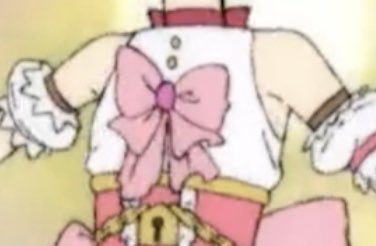
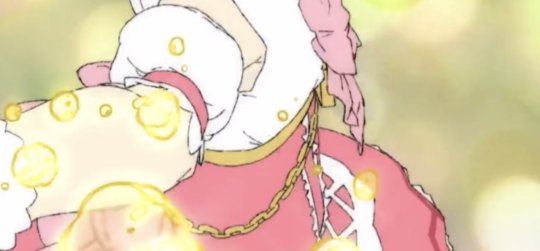
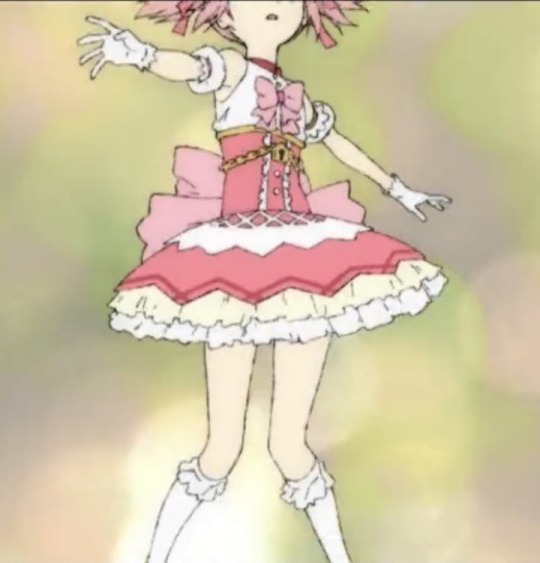
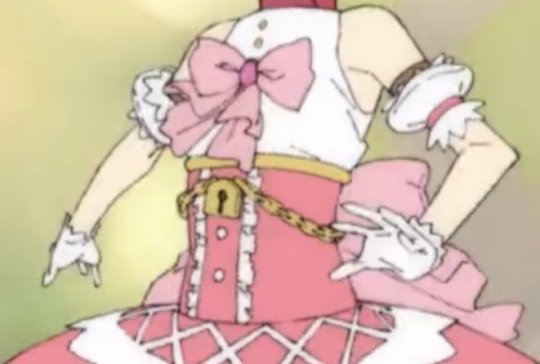
#pmmm#puella magi madoka magica#pmmm rebellion#pmmm walpurgisnacht no kaiten#pmmm walpurgisnacht rising#puella magi madoka magica walpurgis no kaiten#puella magi madoka magica rebellion#mahou shoujo madoka magica#madoka magica#madomagi#madoka kamane#homura akemi#homura x madoka#madohomu#madokami#homucifer#akuma homura#pmmm discussion#pmmm theory#i'm secretly hoping they don't fight but instead use their combined forces to rewrite the universe one last time#but this time they eradicate all Incubators thus they will have never made contracts with girls to begin with#and no magical girls nor witches exist and they're all regular human girls with regular human lives#but that's more like a dream ending of mine i know this new movie will be nothing but pain :“)
354 notes
·
View notes
Text
Do you think if a Magical Girl ate another MG's Soul Gem, they'd ascend into a higher/stronger form of themselves, with remnants of the consumed Gem's magic and personality?
Do you think consuming a Soul Gem also creates a huge implosiom of energy and potential, and deforms the consumer into a different uncontrollable or inhumane form, like the Secret Stones in TotK?
Do you think any of the World Ending Witches (i.e. Walpurgisnatch or the other Record Witches) could've done that as humans and that's why they bevome uber powerful over time?
I'm fascinated by the consumption - literal and otherwise - of souls by other beings with souls.
#yes I refered to other Magical Girls with they because I believe in trans rights#soul gems just look like candy eggs too much for me to not consider Im not sorry#Walpurgisnatch Rising got the think tank goin and I've been workshopping insane SI/OC fic stories#and I remembered TotK and draconification and remember RWBY had an implied in universe souls discussion discourse#and how fucked would it be to become the means by which someone ascends to godhood#with yourself incapable of altering anything as you slowly succumb and cease to be as your soul becomes ones with theirs#puella magi madoka magica#pmmm#madoka magika#madoka magica
17 notes
·
View notes
Text
You know what? I'm going to say it. Every single Madoka Magica ship is unhealthy in its own right. But I'm not just talking about MadoHomu. KyoSaya is also unhealthy to an extent. Hitomi and Kyosuke isn't healthy, either. But it doesn't change how much we all support them. I'm not saying you can't ship them. I'm just stating that they aren't the healthiest relationships.
#puella magi madoka magica#pmmm#mahou shoujo madoka magica#madoka magica#madohomu#madoka x homura#kyosaya#kyoko x sayaka#hitomi x kyosuke#pmmm shipping#shipping discussion#madoka kaname#homura akemi#kaname madoka#akemi homura#kyoko sakura#sakura kyoko#sayaka miki#miki sayaka#hitomi pmmm#kyosuke pmmm
42 notes
·
View notes
Text

DOFSLFODKFJEKCKSJJ DID WE WATCH THE SAME SHOW MAN?????? DID WE?????
When??????? When did we start considering following your wants and needs something bad???????? When did that happen????????????
ESPECIALLY WHEN THOSE WANTS MEAN A REALITY WHERE THE PERSON YOU LOVE DOESN'T KILL HERSELF????????????????
Oh my god. Oh my god holy fucking shit. Madoka's sacrifice shouldn't be interpreted as something simply positive and heroic she stopped existing for fuck's sake. A 14 years old (who's been showing suicidal tendencies since episode 1) sacrificing herself for the good of humanity isn't necessarily a good thing!!!!!!!!!!!!!!! A 14 years old!!!!!!!!!!!!!!!
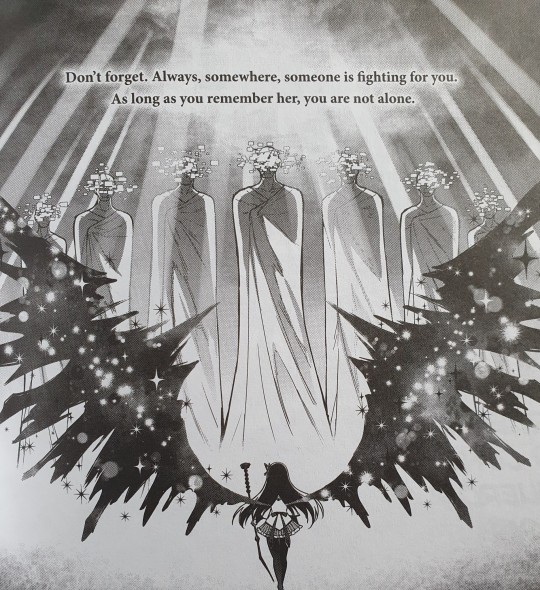
THIS IS HOW THE WHOLE ASS MANGA ENDS AND

THIS IS LITERALLY HOW SHE'S DEPICTED IN THE MOVIE DOVODKVJDNXNXN
#please let's not start a whole discussion about this im just angry man#like what madoka did was good for a lot of people!!! she made a better reality for many many girls!!!! but she doesn’t get to live#in that reality because her existence was deleted!!!!!!! DELETED#we need to recognise this if we want to understand the nuance of the situation#we can recognise sayaka's suicidal tendencies and- uh- whatever the fuck homura's got going on so we have to recognise that madoka's#Not Doing So Well either#sorry 4 the rant watched a rebellion reaction and went insane#might delete this post later idk#puella magi madoka magica#pmmm#madoka magica#madoka kaname#homura akemi#tw self harm#tw suicide
5 notes
·
View notes
Text
madoka magica is a critique of capitalism
just trust me bro once you rewatch it with this in minds its kinda obvious
#nonpl#pmmm#every online discussion about this has been laughed out the room#mostly bc those convos were on reddit n we all know how it is with reddit#i need to rewatch it all before trying to elaborate bc the last time i watched madoka fully was… the first time i watched it fully 💀#<-when i was in middle school
3 notes
·
View notes
Text
Hapuka Birduka to Meduka Meguca
#translation: happy birthday madoka kaname#madoka magica#pmmm#magia record#madoka kaname#for once I don't have a multi-paragraph discussion post planned so y'all get this instead#wonder how many people will rb that thinking about meduka post in her honor
8 notes
·
View notes
Text
Hi, and welcome :)
On hiatus due to exams
(Scroll down for my masterlist)
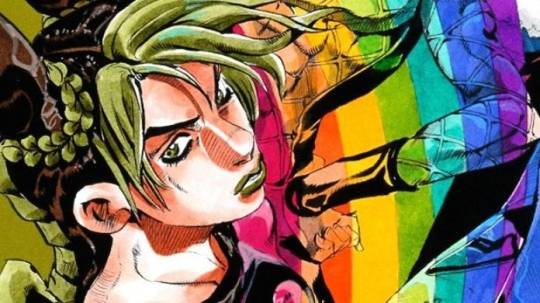
This page is dedicated to reviewing all sorts of anime. I'll be talking about my opinions on characters/anime related topics and controversies too, but that will be less frequent than the reviews. I also often discuss LGBT* representation in anime, especially in regards to queer women
If you have a request, go here or message it to me privately :)
Important:
Before you interact with my content, there are a few things I need to establish. Firstly and most importantly, I do not tolerate hate of any sorts towards anyone, so if you discriminate, get off my page. Secondly, do not interact if you romanticise abuse of any sort. This is a safe space for everyone, and aside from those things I'm very chill.
Please bear in mind that my posts will contain spoilers, because I will talk about the characters/plots of specific anime (I won't give out major spoilers or speak about huge plot twists, it will be done in a similar style to a blurb in a book) so do not interact with my posts if that's a problem. If a certain anime deals with triggering or sensitive topics, I will put a trigger warning before I start talking about the plot and in the tags (if I remember), but let me know if I miss anything - I am always more than happy to correct my mistakes.
I'm happy to interact and answer asks, but spamming and hate will get you blocked
I don't reply to comments due to my glitchy Tumblr, but I read them and appreciate them greatly.
In the interest of keeping my reviews fair and accurate, I will only review anime I have watched at least a season of (please note - where this isn't possible, I will watch all available episodes) but I will not have watched all the anime I talk about until the end (it will be specified when this is the case).
How to navigate my posts
My posts will always contain the following:
Genre: (pretty straightforward, the genre of the anime in the way I interpret it, which could differ from the official one)
Where I watched the anime
A ranking out of 10 on characterization, originality, comfort, addictiveness, art style, setting, plot/storytelling, philosophy (if it made me think/learn something) and consistency (if the quality decreases as the show goes on, with lower ratings meaning it does)
A brief summary of the plot and mentions of the main characters, followed by a discussion on the strong/weak points of the anime
Any extras I think might be useful/interesting.
Current posts
💚 = my personal favourites
💙= PG/family friendly
💜= most popular
Romance
Toradora anime review💙💚
Peach girl anime review💚💜
Citrus anime review
Romance/tragedies
Your lie in April anime review💜💚
Candy candy anime review💚💙
Action/adventure
Attack on Titan anime review💚
My hero academia anime review
Fanservice/Harem
High school dxd anime review
The quintessential quintuplets anime review
Video games
No game no life anime review
Magical girl
Puella magi madoka magica anime review💚
Magia record anime review💜💙
Sailor moon manga review💜
Slice of life/high school/comedy
Lucky star anime review💜💙
Competitions/sports
Food wars anime review💚
Thrillers
Danganronpa anime review💜
Non review content
Why I love and respect Rias Gremory despite the oversex*alised framing of high school dxd 💚
Why Candy is an icon 💙💜💚
My favourite anime women 💚
My favourite anime women pt 2 💚
My love for Sayaka and Kirari 💜💙💚
Sayaka and Kyoko- relationship analysis (pmmm)
Coming soon
My thoughts on obey me (WIP)
Seven deadly sins anime review (WIP)
Jolyne Cujoh and my love for her
Yu gi oh anime review
Anime outfits appreciation
Celebrating found families in anime
Fruits basket anime review
Anohana anime review
Violet Evergarden - its important and timeless message
Kakeguri anime review
Kakeguri twin anime review
Mary Saotome- A lesson in character development
Thank you and I look forward to posting !! 💙💚💜
#anime and manga#anime review#anime discussion#anime fandom#writing#anime reccs#anime recommendation#toradora review#pmmm review#danganrompa review#high school dxd review#attack on titan review#magia record review#your lie in april review#lucky star review#food wars review#mha review#sailor moon review#no game no life review#peach girl review#jolyneswifeanimereviews
9 notes
·
View notes
Text
If i ever talk about madoka magica for more than two paragraphs and dont make it about feminism i hope you find me in the alien spaceship ive been abducted to
#everytime i think about madoka magica my feminism brain goes brrrrrr#theres so much there to discuss#i can feminism almost everything in madoka magica just watch me#i need to read more feminism madoka magica think pieces#puella magi madoka magica#pmmm
3 notes
·
View notes
Text
There is a tendency I see in PMMM analyses and discussions to treat the witches simply as monsters that can be overcome with sufficient force regardless of other circumstances--and thus Homura's failure to ever win against Walpurgisnacht on her own terms is something that could be easily fixed with more firepower and different tactics. And while there's nothing wrong with this interpretation, it's not one that particularly interests me, either.
What I like about PMMM and what makes it so engaging for me, is that it can be read on multiple levels--both as a literal journey and as a symbolic one. In-universe, witches are the shadow selves of magical girls; is it really so surprising that they also serve as narrative foils to those who face them, thus making victory or defeat as much of a character issue as a tactical one?
It is not a coincidence that Mami Tomoe, a girl who was forced to grow up too fast and who could have wished to save her dying parents but didn't, meets her end at the hand of a particularly childish and immature witch, a lumpen, misshapen doll that transforms into a clown--a girl who never grew up, who could have wished to save her dying parent but didn't. Mami, an experienced veteran who wiped the floor with the Rose Witch and her familiars earlier, is completely caught off-guard and is eaten alive by a witch who embodies all of the issues she herself struggles with and has yet to overcome within herself.
Yes, Mami was careless and overconfident, which led to her doom--but she had also fulfilled her role of introducing Madoka to the world of magical girls. On a narrative level, her death was necessary--not only to free Madoka from her impulsive promise to become a magical girl too early in the story, before she'd learned all the facts and could make a fully informed decision, but also to teach Madoka one final, horrific lesson about what life as a magical girl is really like.
This is not to say that AUs where Mami survives are wrong or missing the point--I've written them myself and I love them! (It helps that Mami's survival is usually the result of someone else's interference, not something she accomplishes on her own.) Nor do I mean to suggest that Mami's death is a moral failing on her part--merely that I think that Charlotte represents Mami's own particular brand of kryptonite at that particular point in her life, one she might have been able to survive if she had been able to move beyond the psychological issues hobbling her.
Meanwhile, Homura is able to easily defeat Charlotte, because metaphorically she's moved beyond the childish worldview that Mami is still stuck in. From that same symbolic perspective, it's this relative level of maturity, as much as her time stop and pipe bombs, that allows her to win.
Likewise, it is not an accident that the next witch Madoka encounters is one that specializes in extracting the memories of its victims, trapping Madoka in a spinning carousel as she is tormented by her own grief and guilty conscience over Mami's death. She is freed by Sayaka, who has moved beyond such angst by her decision to take on Mami's role as an idealized magical girl protector. Later on, Sayaka's descent into dualistic thinking is symbolized by her fight against a witch whose world is literally black and white--whom Sayaka defeats, but only at the cost of pushing herself dangerously to her limits.
As with Mami, Sayaka's death is directly tied to her own psychological issues--in this case, by her incredibly strict rules about how magical girls should behave and her refusal to cut herself any slack whatsoever. Her metaphorical self-denial results in literal self-denial, and her death as a magical girl and rebirth as a witch.
Then we come to Walpurgisnacht, a witch made of cogs and gears--the one witch Homura cannot beat, no matter what she does. Homura is stuck in her loops, unable to imagine a future beyond them, increasingly isolated from any meaningful connections or relationships--Walpurgisnacht may be the "fool that spins in a circle", but so is Homura. The inside mirrors the outside; when we watch Homura fight against Walpurgisnacht, we are also watching Homura's struggle with herself. Unlike Mami and Sayaka, Homura's magic allows her to fight this battle over and over again--again and again she is forced to retreat and start over, unsatisfied with the results and determined to do better next time. She doesn't die, but she doesn't win, either--instead, she's locked into perpetual stalemate with no end.
Madoka, however, is able to see beyond the vicious cycle represented by Walpurgisnacht and thus easily and repeatedly defeats an enemy that Homura cannot, regardless of her relative power levels in any given timeline. It's probably too simplistic to say that hope triumphs over despair--and yet, that's exactly what happens, every single time. Homura has numbed herself through repeated exposure to where she no longer feels hope or despair, thus existing in perpetual stasis with her purpose the only thing driving her. Paradoxically, the one thing she needs to do to win is the one thing she cannot do--and the thing that Madoka can do all too easily.
(This is not to say that Madoka doesn't have her own issues--she does!--just that her issues are different from Homura's, meaning she's not tripped up by this particular obstacle in the same way that Homura is. And it's not that Homura's struggles were pointless--they were what allowed Madoka to get to point where she had both the power and the knowledge that she could save everyone, including Homura.)
Homura's final battle with Walpurgisnacht shows Homura going to insane lengths, including a wall of C-4 explosives inside a refinery, a flaming oil tanker, and a submarine with Type 88 Surface-to-Ship missiles--none of which has any lasting effect on Walpurgisnacht whatsoever. That episode goes to great lengths to show that Homura's approach to fighting Walpurgisnacht fundamentally isn't working; I don't think adding more nukes would help.
The one time Homura gets the closest to her happy ending is the one timeline where she and Madoka fight and fall together--the one timeline where they are shown as equals, and the one where they debate becoming witches together and destroying the whole world before Madoka thinks better of it. This is also not a coincidence. If there is ever to be a truly happy end to this franchise--or an end at all--Homura and Madoka must be equal and willing partners, not one protecting/sacrificing themself for the other again and again. It is also likely that they will remake the universe in the process, through the combined power of their mutual wish.
[It also wouldn't surprise me if that line foreshadowed future plot elements--after all, Madoka technically became a witch in the final episode of the TV series (she got better, thanks to the nature of her wish), and so did Homura in Rebellion--but we shall see if the series ever follows up on this.]
This is why I'm so excited that Walpurgis no Kaiten seems to be laying the groundwork for Homura creating her own enemies and her greatest enemy being herself--once again, making the metaphorical literal. I'm excited about the prospect of Homura getting a do-over with Walpurgisnacht, which would represent a chance for her to confront her narrative foil one more time, and show us how her character has changed. Though it may play out on a larger stage, the real battle will be inside Homura's mind and heart--and, I would argue, always has been. The only way the outcome will change--the only way we can move beyond what's been and into something new--is if/when she changes.
I want to be clear that there's absolutely nothing wrong with the strictly literal interpretation of witches, and I think people should write what they want to write; if that's the story you want to tell, then go for it! For me, however, I find it far more compelling--not to mention richer and truer--if the actions and words on-screen correspond to the characters' emotional and psychological journeys, and there's no question that this preference how I interpret media in general, and PMMM in particular. And it's not that I think Homura couldn't defeat Walpurgisnacht in an AU scenario--merely that any story where she achieves this victory without changing in any way or addressing her own psychological issues in some fashion removes exactly the elements that drew me to this series in the first place.
1K notes
·
View notes
Text
Ugh.... My Madoka Magica rant is getting too much attention. To be honest, I closed Tumblr immediately after posting it bc I was scared this would happen.
With how much hate Homura is gonna get in Walpurgisnacht Rising simply for existing, I really just wanted to debunk the decade-long, unfairly popularized assumption that Homura was wrong to make Madoka human again and reunite her with her family and friends when it's literally canon that Madoka was lonely and sad in “heaven” as a goddess and I wanted to clear Homura's name before she gets anymore hate in this new movie. I also wanted to bring more clarity to Madoka's character seeing as how most seem to not understand that she has much more value beyond her ultimate sacrifice and her godhood, more importantly that she hides how she feels behind her pink and friendly demeanor most of the time and it feels like everyone fell for it considering they just.... assume she wanted to be trapped in a space prison of isolation where nobody even misses nor cares about her bc nobody knows she exists?? But between those who lack reading comprehension skills and those who've been dead-set on Homura being this evil monster with Madoka as her unwilling victim for over 10 years now, I don't want my post starting discourse that'll only double with whatever happens in Walpurgisnacht Rising...
#pmmm#puella magi madoka magica#madoka magica#mahou shoujo madoka magica#pmmm rebellion#puella magi madoka magica rebellion#pmmm walpurgisnacht no kaiten#pmmm walpurgisnacht rising#walpurgis no kaiten#walpurgisnacht rising#madomagi#madoka kamane#homura akemi#madokami#homucifer#homura x madoka#madoka x homura#madohomu#pmmm discussion#i always get scared of speaking my mind when it comes to madomagi because one way or another discourse starts...#it's not bad right now but if it suddenly blows up with homura antis i might have to delete
66 notes
·
View notes
Text
I am once again going to talk too much about Rebellion
and how people don’t understand Homura. Here I would like to address the reasons why people call Homura evil/the antagonist, which is usually their reason for disliking Rebellion. My blog has basically morphed into an obsessive discussion on why that movie is my favorite and elevates the story, so I’ve covered a lot of these topics before, but I hope to make things more comprehensive here.
I’ve seen some people call Homura “corrupted” by the part of her that is a witch. Two thoughts on that:
Rebellion goes out of its way to show you that witches are not inherently evil. They have experienced serious pain and are spreading that pain before Madoka’s sacrifice. However, if this meant that witches were inherently evil, then why are Sayaka and Nagisa not? They are still witches- that’s why their witch forms are still a part of them.
Also, in Rebellion, Sayaka warns Madoka’s essence to not fear Homura, as “she’s the one who’s most hurt”.
I think that people misunderstand the theme of what a witch is overall. A witch is an inevitable reality of magical girls because being a girl in a patriarchal/Kyubey system is CRUSHING. The transformation into a witch is a coming-of-age step into womanhood. It comes from the culmination of mistreatments and systemic oppression girls inevitably become overwhelmed by. This isn’t to say that all women are forever overwhelmed, but it is an unpleasant reality that most women become awoken to. Think of the resolution of the Barbie movie, for instance, where (BARBIE SPOILERS) the characters need to “wake up” the others to the suffocating reality of living in a patriarchy. Same principle, honestly.
I also think that people sometimes interpret the Christian imagery in a stereotypical “good vs evil” way than looking at the situation, especially when it comes to Homura’s demon label and Madoka’s sacrifice.
I’ve talked about this a lot so I won’t go into too much detail, but I believe that the series is going out of its way to create its themes around the dark reality of the self-sacrificing nature of girls. For a brief recap:
Making wishes for someone else is considered taboo
Madoka mattered as a girl. Throughout all iterations of pmmm and its sequels, Madoka laments on the tragedy of magical girls vanishing from the world without anyone knowing and says in Rebellion that she would never want to go anywhere where she couldn’t be around her friends and family. Her mom had plans for them when Madoka grew up, her brother remembers her, and it drives Homura insane that she’s the only person who remembers the other timeline. Madoka was always worried that she wasn’t good enough at anything to have a place in the world and I truly have a hard time believing that this series is saying that young girls who don’t feel they have value anywhere else are best served to sacrifice themselves into oblivion. That’s basically been the history of women, forever.
Homura calls herself a demon because, “[Madoka] was sacred as a god and I couldn’t help but pull her from heaven and undermine her.” Throughout the Wraith Cycle, Homura commits herself to honoring Madoka’s sacrifice and new world order, so the phrase “and I couldn’t help but pull her from heaven undermine her” is, I think, more of a reflection of her self-loathing for going against Madoka’s wish and less of a true admission of evil, because I don’t think that Madoka’s erasure from the world was ever an okay thing. I think people get too hung up on “demon-bad” without thinking of the nuances of the imagery. I don’t believe that Madoka’s godhood is inherently good, and I don’t believe Homura’s demonhood is inherently bad. I think that Madoka’s godhood is more an alignment with self-sacrifice, and Homura’s demonhood is an alignment with desire, and I think that too much of either is a bad thing. It’s why they both needed to come together to eviscerate the Kyubeys.
I think that the label of “demon” makes Homura irredeemable to people and I think that people are deeply unforgiving of the not so pretty things that make us human. I’ve seen that a lot of what I assume are younger users are completely unforgiving to girl characters who go through things and make mistakes. I’m not even talking about Azula defenders (though I think there is a nuanced conversation there) but the Catra-type haters. As others have pointed out, ya’ll about women’s wrongs until a girl suffers a time loop to try to save the love of her life (who, lest we forget, begs Homura to shoot her in one timeline) and her friends and almost loses her mind by being the only person to remember the love of her life in the timeline that ya’ll think was the good one. I even hesitate to call it “toxic yuri” until the last movie comes out. Now, this isn’t to say that Homura has made no mistakes. I think the fact that her rewriting of the world to include the Kyubeys is going to be a BIG mistake on her part, and she did pull the identity of Madoka away from the Law of the Cycle against her wishes. But I think that to take everything Homura has done to try to save Madoka and even give Madoka the power to become the Law of the Cycle and say that she is irredeemable or toxic because she is traumatized…. It’s heartbreaking to me.
Moreover, this perception of Homura as irredeemable flies in the face of all this Christian imagery. Throughout the entirety of Rebellion’s ending (and as you’ll see further down) Madoka assures Homura that she loves her no matter what, that she is always there for her. Madoka in her fullness can see in intimate detail what Homura endured for her- literal YEARS of suffering yet never giving up- do you really think Goddess Madoka can’t and shouldn’t forgive Homura? Are the “good” guys in Christianity not all about forgiveness?
And finally, the real reason I made this long ass post: Homura and Rue from Princess Tutu are parallels. For those who don’t know: in Princess Tutu, the character Rue transforms into an “evil” persona- Princess Kraehe, daughter of the Crow. While Rue is convinced that she is now an agent of evil, the main character Ahiru/Duck insists that she is not. Also important to note is Rue may not rewrite the universe, but objectively commits more women’s wrongs than Homura. She rips the shards of emotion from her lover’s breast and tries to sacrifice innocent people’s hearts to her father, but the story does not paint her as condemned or irredeemable. She’s been lied to, groomed, and traumatized. She’s not an evil person, she’s a girl trying to navigate horrible circumstances, like Homura. Rebellion creates these parallels because Homura is forgivable and it wants you to know that.
So anyway, first parallel is the outfit. Demon Homura is SOOOOO inspired by Kraehe it HURTS:


And finally, Rebellion went so hard to reference this scene:
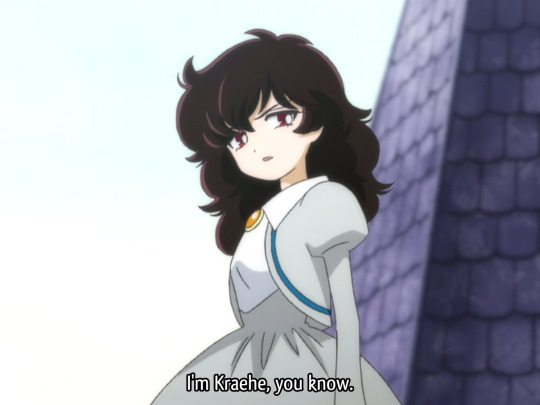

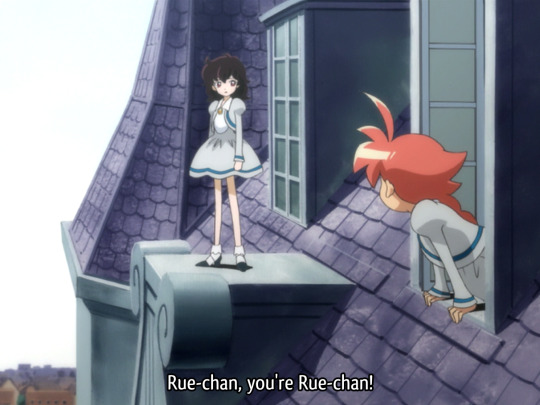
PLEASE put on sound they translate it differently but here she says "homura chan is homura chan"
so yeah if you stuck around thanks! love u muah
#madoka magica#homura akemi#puella magi madoka magica#pmmm homura#pmmm#princess tutu#princess kraehe#Princess Tutu spoilers#support womens wrongs#but actually support them#madoka kaname#madoka magica rebellion#walpurgisnacht rising#walpurgis no kaiten
256 notes
·
View notes
Text
we as a fandom have never discussed the implications that come from kyubey merchandise such as costumes and pajamas existing in-universe in pmmm (including variations, like here). is there a rogue magical girl obsessed with making kyubey merch? was his species pitched as "fantasy" in-universe? what.
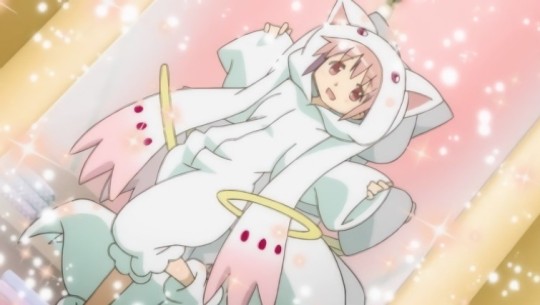
#I KNOW IT'S JUST BECAUSE RULE OF CUTE PLEASE DON'T @ ME#sambling#pmmm#madoka magica#edit: fixed typo and grammar issue
113 notes
·
View notes
Text
okie okie i don't currently have the energy to elaborate on my thoughts, but a few things from the pmmm trailer i wanted to point out!!


the symbol homura is seen with when summoning the phone is mirrored in the gleam of the arrow seen later


the flower arch behind madoka has gears in it rather than flowers!!
also: could the mention of dreams in the trailer relate at all to the nightmares in rebellion?
oh, and i know ive seen people talk about walpurgisnacht making one half of an hourglass with gretchen, but i dont know if ive seen much about the gear that makes up walpurgisnacht's core and the relevance of gears to clocks & thereby their association with "setting back the clock" & homura. we see madoka crucified on a gear/clock in the original series when kyubey and homura are discussing the fate the latter has doomed madoka to
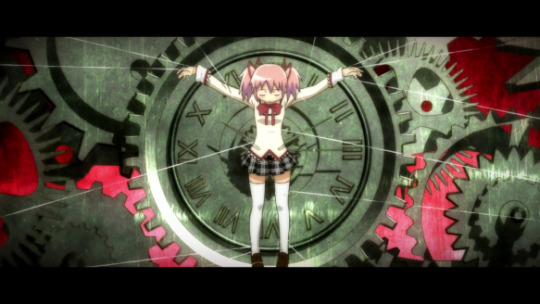
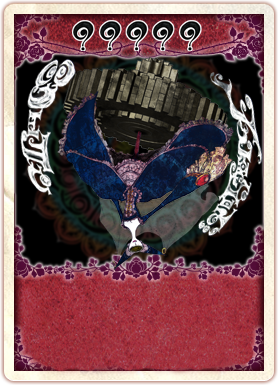
i think that's another point to the "homura becomes walpurgisnacht" theory!
these are just a few things i haven't noticed as much discussion of yet (sorry if theyve been pointed out before!!) i definitely want to elaborate more on my thoughts, but i am chronically sleepy, so ill probably do it in lil bursts ♡ id love for anyone who has thought on these elements to share!!
i hope you find reason to smile today, and dont forget to hydrate!! ♡
#madoka magica#walpurgis no kaiten#pmmm#im so excited for this movie!!#this series has genuinely changed my life ♡#ive never related to a character more than madoka kaname & it gives me hope to see her spread happiness#i hope i can do the same#oh im rambling oops#anyway here are some lil details for yall!!#much love ♡#why did the screenshots all have a black border :(
98 notes
·
View notes
Text

Assorted Bonesaws.
I don't draw as much Riley as I'd like to these days but I don't talk to anyone much about Worm so it's hard to come up with ideas. As opposed to PMMM which I am constantly discussing in Discord.
Still, beloved blorbo.
#parahumans#worm web serial#wormblr#bonesaw#riley grace davis#slaughterhouse nine#blood#art#fan art#my art
640 notes
·
View notes
Note
Madoka question: does the show/supplementary material ever explain how Familiars come into existence along with Witches? I was discussing this with a friend and I realized that while a lot is inferred I couldn't remember an explicit explanation.
Yes, there actually is an explanation! According to a magazine interview given when the Madoka PSP game was released, familiars are "projections of the magical girl's heart before she became a witch."
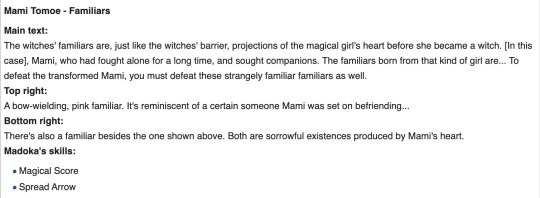
For example, Candeloro's (Mami's Witch) familiars resemble Kyoko and Madoka, symbolizing Mami's desire to be with them. Oktavia's (Sayaka's Witch) has a familiar that resembles Kyosuke, and in one of the timelines also has familiars that look like Hitomi. Charlotte's familiars look like nurses, which (if we go by the Magia Record explanation of Nagisa's backstory) would have been a common sight for Nagisa as she visited her mother in the hospital every day.
Also, the official glossary term from the PMMM website provides more explanation on familiars:
"Lesser monsters divided out of the essence of a witch. Though normally assigned the task of maintaining and defending their mistress' barrier, it seems that they can eventually gain independence and stray to form their own barriers."
So basically, familiars are created from the essence of their parent Witch and are a projection of her heart at the time she became a Witch. They perform various duties around the barrier.
211 notes
·
View notes
Note
Spill your twst and madoka magica thoughts like a bucket of milk so I may be the cat that gets the cream (I, too, like both pieces of media and would love to see your thoughts 〜(꒪꒳꒪)〜)
Thanks for indulging me, haha <33 I prob forgot some stuff, but here’s what I thought of for now
Malleus is a very similar archetype to Homura. They both play the role of the social outcast who is incredibly lonely (and depressed in Homura’s case) because of their inability to fit in and have friends partially due to facing social isolation for most of their life (Homura was hospital-bound and Malleus was trapped in his castle). Also, they are/become the absolute chads of the universe basically invincible and unbeatable by anyone. They even have the same personality type (INTJ).
Then, one single person decides to befriend them. Obviously, Madoka and Yuu, the main characters of the series. The rest is me projecting a bit (non-canon for twst) because I love Malleyuu and I’m delusional, but I imagine if the ship were to happen their dynamic would be very similar to Madoka and Homura, where Yuu is mostly being kind/friendly/wholesome to him which causes Malleus to become very attached/protective over Yuu, one of the only people to ever genuinely care for him.
If you’ve ever seen that one scene of Madoka hugging Homura in the first timeline, that’s exactly how I imagine Malleus would be getting his first hug from Yuu.
Discussion about Malleus’ overblot and Homura’s actions in rebellion under the cut **spoilers**
If we look at Homura’s actions in rebellion, they’re so similar to what Malleus does during his overblot, except instead of a doing it for a friend/love interest, he does it for familial love.
Both are in a position where their loved one experiences suffering and/or (future) death. I won’t explain what happens to Madoka for those who don’t know because it’s super complicated, but basically Homura feels that she must save her from this situation, and is also very lost without Madoka by her side.
What do they both do? Create an alternate dream/universe where basically everyone is happy. It’s different in his overblot because of the different dreams versus one shared universe in Homura’s case, but it’s essentially the same in terms of the goal. Malleus creates dreams where everyone can have their own happiness, Homura creates a universe where the magical girls no longer have to be such, fight witches, and just generally suffer. All of them have their own individual details of happiness too, like Sayaka and Kyoko living together. Homura put that into this world even though she didn’t have to, only to make them happy, although she claims Madoka is her only priority.
These actions remind me so much of each other, especially the feeling of ‘I’m willing to be the villain if it means everyone else gets to be happy.’ Both of them know what they’ve done is fundamentally wrong on some level, but they’re willing to do what it takes to see their loved ones happy, no matter what extreme actions they must commit.
Both actions are also driven by the same desperation to keep their loved one by their side and the side of their own loved ones (e.g. Malleus doing it for Silver after seeing his grief over Lilia, Homura partially doing it for Madoka’s friends/family).
Also, overblots have a similar mechanic in madoka magica, that being a magical girl turning into a witch when falling into despair.
Obviously magic users are equivalent to magical girls in pmmm, and they also have an equivalent to magic pens, those being soul gems.
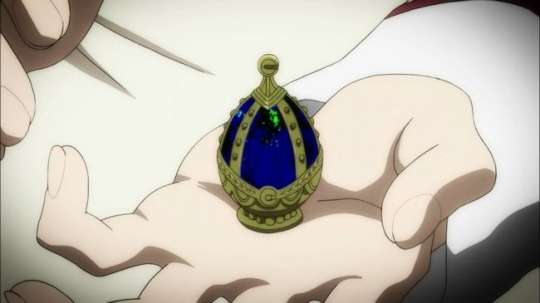
The final form of a magical girl is a witch, in the same way that the final form of an overblot (if not stopped) is a phantom. When a magical girl’s soul gem becomes too polluted (from despair or not being cleansed from fighting a witch), she must cleanse it, and if she doesn’t she will become a witch. This is clearly similar to twst, where magic users can’t use too much magic and accumulate blot, or else they will overblot. Also, the emotional aspect of despair is a huge theme in twst as well during their overblots.
There is a difference in that all magical girls become witches (an existence of suffering and madness where they are not akin to their magical girl selves at all). This is pretty similar to the overblot phantoms seem in book 6. The other magical girls then have to fight the witch to stop it from hurting people/causing chaos and destruction. They’re often (sometimes unknowingly) fighting their own friends in witch form, similar to how nrc boys have been forced to fight their classmates when in overblot form.
It’s interesting to think if twst was a darker game and they took the route of ‘once you overblot there’s no coming back’ because that’s basically how it is in pmmm.
Anyway, thanks for listening to my rambles!!
#these are prob my two fav characters in all of fiction lol#malleus draconia#homura akemi#twst spoilers#twst#madoka magica#twisted wonderland#pmmm
37 notes
·
View notes